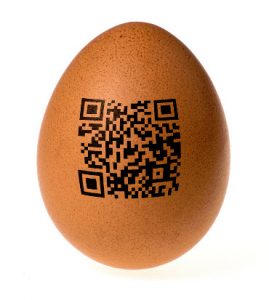
QR Code Technology in Dairy Industry (Latest Digital Technology)
QR Code Technology
Food from dairy animals has a critical place in the human food chain. Since diseases can be transmitted from animals to humans, food safety has become an important concern for consumers and regulators. With increased awareness about the source of food, its traceability has assumed great importance. Many countries have passed laws on the traceability of the food chain to ensure compliance with standards of safety and quality. These laws put the responsibility of maintaining milk and meat quality standards on producers, who in turn demand responsible input material supplies such as feed, supplements, vaccines, and other raw materials. Since the animal is the primary source of milk, the inputs need to be traced and monitored from farm to doorstep.
Individual animal identification is the first step in this system, with a unique number allocated by the farmer or dairy manager. The Government of India has recognized its importance and has rolled out an elaborate program of animal identification.
Technology in this field has evolved much in the last twenty years. All over the world, farmers have been using new technologies to communicate with their consumers in innovative ways. In the past, cows in Britain were taken to Sales Yards for auction. These Sales Yards were a modern version of rural Indian livestock markets. However, prospective buyers were not satisfied with the information provided at these auctions.
QR codes are now used to easily convey information in many industries, including dairy and food. QR codes are two-dimension code that can be generated to connect to a ‘Uniform Resource Locator’ also commonly called URL. The URL is a link to a website where a file containing information can be uploaded. The QR code can be scanned with mobile phones using a free App, to connect to a URL and display the contents of the file on the phone. This technology was used in 2010 at cow auctions in the United Kingdom, with the QR code being painted on the sides of cows. For this they used a QR printed stencil and washable paint. The idea attracted a lot of interest but creating stencils, painting cows, and washing up after auction was more time consuming for busy farmers.
In June 2012 an interesting story appeared in ‘BBC News’ about James Barnes of Somerby, Leicestershire. James, a farmer who used milk from his farm to make premium Stilton Cheese, painted QR codes on his cows so that visitors learn about his farm and the process followed in the making of the products bought by them. French farmers also adopted this technique, using this technology to get around a ban on advertising of milk by using their cows as billboards.

Another interesting experiment was done with QR code printed on eggs. A company in the United States made a deal with a major egg supplier to print egg shells with QR codes of their products. The idea was to use egg shell as the marketing billboards. To attract consumers and encourage them to scan these eggs, they hide golden prized codes in few eggs. This idea did not move forward because of logistical difficulties.
In a major breakthrough, animal identification ear tags have been developed and patented. The ear tags are printed with a cryptic QR code replacing the linear bar code. The cryptic code provides a link to the data file of the animal. The animal’s information can be downloaded from a cloud server by scanning the ear tag with a phone-based QR scanner. One of the main advantages of this system is that data can only be entered by scanning the QR code, thus preventing false data from being uploaded.
Once the animal is tagged, lifetime records of the animal can be accessed anywhere or anytime by simply scanning the code with a phone. Farmers can register their animals by paying a nominal one-time fee and get the benefit of data management support for their herd. Over 1.3 lakh cows in three states have already been tagged and registered by a leading milk processing company in South India. Total veterinary services, genetic improvement, and productivity enhancement programmes are being implemented using this system. This technology offers tremendous potential to implement traceability programs for stray cattle, transportation of cattle and farm-to-fork movement of food.
Dr. Abdul Samad
